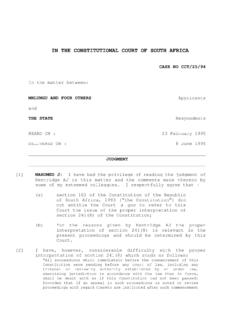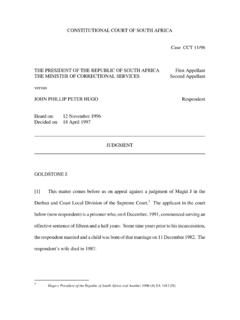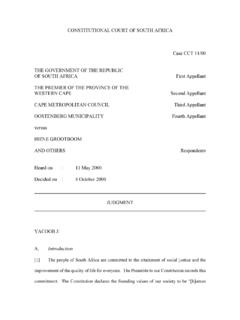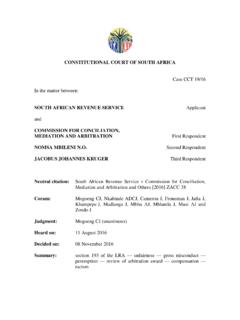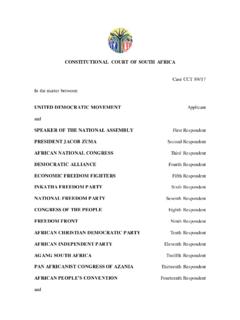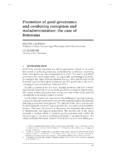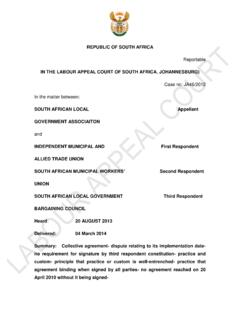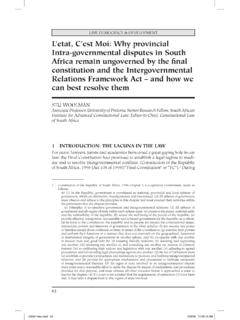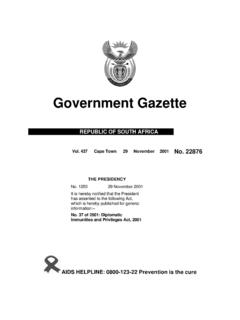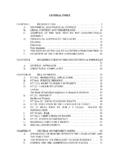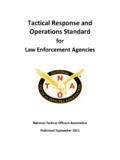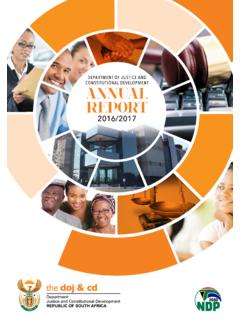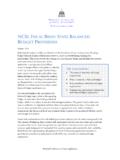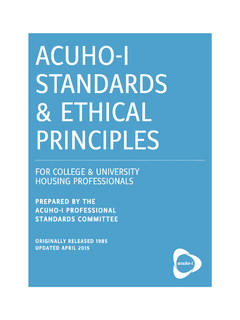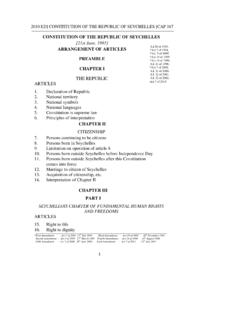Transcription of Case CCT 21/01 HERMANUS FREDERICK VAN …
1 constitutional COURT OF SOUTH AFRICA Case CCT 21/01 HERMANUS FREDERICK VAN ROOYEN First Applicant ADRIAAN CHRISTIAAN BEKKER Second Applicant THE ASSOCIATION OF REGIONAL MAGISTRATES OF SOUTH AFRICA Third Applicant versus THE STATE First Respondent GEORGE BIBI TSHABALALA Second Respondent G N TRAVERS Third Respondent THE MINISTER OF JUSTICE Fourth Respondent THE ATTORNEY-GENERAL, TRANSVAAL Fifth Respondent VASSILIS THEMELAROS Sixth Respondent B BOOYSEN Seventh Respondent GENERAL COUNCIL OF THE BAR OF SOUTH AFRICA Intervener Heard on : 10 and 11 September 2001 Decided on : 11 June 2002 JUDGMENT CHASKALSON CJ: CHASKALSON CJ Introduction 1 The first applicant (Van Rooyen) was convicted in the Pretoria Regional Court on various counts of theft and the unlawful possession of a firearm and ammunition.
2 He was sentenced to imprisonment for periods amounting in all to six years. The presiding magistrate in his case was the third respondent (Travers). Van Rooyen noted an appeal to the High Court in Pretoria (the High Court) against his conviction and sentence in which he disputed the findings that Travers made on the merits, and also challenged the legality of the proceedings in the Regional Court, contending that the court lacks the institutional independence and required by the Constitution. He subsequently sought to supplement his appeal by review proceedings in which similar issues pertaining to the lack of institutional independence of the Regional Court were raised. 2 The second respondent (Tshabalala) was charged in the Pretoria Regional Court with murder and malicious injury to property. He also appeared before Travers and applied for bail which was refused. He noted an appeal to the High Court against that order which failed. He subsequently instituted review proceedings in which he sought to set aside the proceedings on various grounds, including that the Regional Court lacked the institutional independence that the Constitution requires.
3 In the meantime the sixth respondent (Themalaros) was called upon to face charges of fraud in the Regional Court at Pretoria. He entered a plea to the effect that the court had no jurisdiction to try him because it was not an independent court as contemplated in section 165(2) of the Constitution. His case was heard by the seventh respondent (Booysen) who upheld the plea and referred the matter to the High Court. The fifth respondent, now known as 2 CHASKALSON CJ the Director of Public Prosecutions,1 then applied to the High Court to review and set Booysen=s decision aside. 3 These three matters were subsequently consolidated for the purpose of the hearing of the appeals and reviews in the High Court.
4 They raised important issues concerning the constitutionality of provisions of the Magistrates= Courts Act,2 the Magistrates Act,3 and 1 In terms of section 43(1)(a) of the National Prosecuting Authority Act 32 of 1998 anyone holding office as Attorney-General was deemed to have been appointed as Director of Public Prosecutions under that Act. This change occurred after the institution of the proceedings, but before judgment had been given by the High Court. 2 Act 32 of 1944. 3 Act 90 of 1993. 3 CHASKALSON CJ regulations made in terms of the Magistrates The third applicant B the Association of Regional Magistrates of South Africa (ARMSA) B and the second applicant (Bekker) who is a regional magistrate, were given leave to intervene in the proceedings and did so.
5 4 Regulations for Judicial Officers in the Lower Courts, 1993 promulgated in Government Gazette 15524 GN R361, 11 March 1994 (as amended) and Complaints Procedure Regulations promulgated in Government Gazette 19309 GN R1240, 1 October 1998. 4 CHASKALSON CJ 4 The matter, involving these various parties with different interests, came before a court of two judges of the High Court. The papers were voluminous and complex. After argument had been heard on the various issues that had been raised but before judgment could be given, one of the judges who had sat in the matter died.
6 A judgment was subsequently delivered by the remaining All the parties had previously reached agreement in writing to accept the decision of the remaining judge as the decision of the It was not disputed that he had the 5 The judgment has been reported as Van Rooyen and Others v The State and Others 2001 (4) SA 396 (T); 2001 (9) BCLR 915 (T). References in this judgment will be to the report in the South African Law Reports. 6 Id at 416I. 5 CHASKALSON CJ power to do so in terms of section 17(2) of the Supreme Court 5 The judge upheld the application of the Director of Public Prosecutions to review the judgment in the Themalaros case, and dismissed the applications by Van Rooyen and Tshabalala to review the decisions given in their cases.
7 He also dismissed Van Rooyen=s appeal against the convictions and sentences imposed on him. He concluded, however, that various provisions of the legislation and regulations which had been challenged were indeed inconsistent with the Constitution and accordingly invalid. To avoid any disruption in the functioning of the courts consequent upon such a finding, he directed that the operation of the order made by him be suspended for 9 months to enable the executive and legislature to remedy the deficiencies in the 7 Section 17(2) of Act 59 of 1959 provides: AIf at any stage during the hearing of any matter by a full court, any judge of such court dies or retires or is otherwise incapable of acting or is absent, the hearing shall, if the remaining judges constitute a majority of the judges before whom it was commenced, proceed before such remaining judges, and if such remaining judges do not constitute such a majority, or if only one judge remains, the hearing shall be commenced de novo, unless all the parties to the proceedings agree unconditionally in writing to accept the decision of the majority of such remaining judges or of such one remaining judge as the decision of the court.
8 @ 6 CHASKALSON CJ legislation. I deal later with the details of the provisions that were declared to be inconsistent with the Constitution. 6 In terms of section 172(2) of the Constitution the order of invalidity, insofar as it pertains to the provisions of the two Acts, is of no force or effect unless confirmed by this Court. The judge accordingly directed the registrar of the High Court to refer the order made by him to this Court to consider whether or not the declarations of invalidity made in respect of the two Acts should be confirmed. This is a requirement of the constitutional Court Complementary Act,8 and rule 15 of the rules of this 7 Van Rooyen, Bekker and ARMSA then applied to this Court for the order to be confirmed.
9 The state, the Minister of Justice and the Director of Public Prosecutions opposed the confirmation of the order and also noted an appeal to this Court against the order made by the 8 Section 8(1)(a) of Act 13 of 1995. 9 Rule 15(1) provides: AThe registrar of a court which has made an order of constitutional invalidity as contemplated in section 172 of the Constitution shall, within 15 days of such order, lodge with the registrar of the Court a copy of such order.@ 7 CHASKALSON CJ High Court. Their appeal was noted in terms of section 172(2)(d) of the Constitution which provides: AAny person or organ of state with a sufficient interest may appeal, or apply, directly to the constitutional Court to confirm or vary any order of constitutional invalidity by a court in terms of this subsection.
10 @ 8 Section 172(2)(d) governs appeals against orders of invalidity made concerning an Act of Parliament, a Provincial Act or any conduct of the President. It has no application to declarations of invalidity made in respect of other legislation or As far as such matters are concerned, an appeal may be brought only with the leave of this Court and in accordance with the requirements of its The relevant rule is rule 18 which requires an aggrieved litigant to apply to the High Court concerned for a certificate that the constitutional matter is one of substance on which a ruling by this Court is desirable, that there is sufficient evidence on record to enable this Court to dispose of the matter and that there is a reasonable prospect that this Court will reverse or materially alter the judgment if leave to appeal is given. 10 Dawood and Another v Minister of Home Affairs and Others; Shalabi and Another v Minister of Home Affairs and Others; Thomas and Another v Minister of Home Affairs and Others 2000 (3) SA 936 (CC)(cc); 2000 (8) BCLR 837 (CC) at para 11; Booysen and Others v Minister of Home Affairs and Another 2001 (4) SA 485 (CC); 2001 (7) BCLR 645 (CC) at para 1; Minister of Home Affairs v Liebenberg 2002 (1) SA 33; 2001 (11) BCLR 1168 (CC) at para 9.
